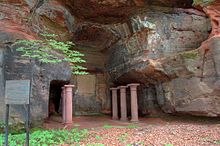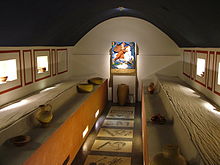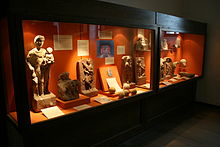- Mithraeum
-
 A mithraeum found in the ruins of Ostia Antica, Italy
A mithraeum found in the ruins of Ostia Antica, Italy
 A mithraeum found in the German city of Saarbrücken
A mithraeum found in the German city of Saarbrücken
A Mithraeum is a place of worship for the followers of the mystery religion of Mithraism.
The Mithraeum was either an adapted natural cave or cavern or an artificial building imitating a cavern. Mithraea were dark and windowless, even if they were not actually in a subterranean space or in a natural cave. When possible, the mithraeum was constructed within or below an existing building. The site of a mithraeum may also be identified by its separate entrance or vestibule, its "cave", called the spelaeum or spelunca, with raised benches along the side walls for the ritual meal, and its sanctuary at the far end, often in a recess, before which the pedestal-like altar stood. Many mithraea that follow this basic plan are scattered over much of the Roman Empire's former area, particularly where the legions were stationed along the frontiers (such as Britain). Others may be recognized by their characteristic layout, even though converted as crypts beneath Christian churches.
From the structure of the mithraea it is possible to surmise that worshippers would have gathered for a common meal along the reclining couches lining the walls. Most temples could hold only thirty or forty individuals.
The mithraeum itself was arranged as an "image of the universe". It is noticed by some researchers that this movement, especially in the context of mithraic iconography (see below), seems to stem from the neoplatonic concept that the "running" of the sun from solstice to solstice is a parallel for the movement of the soul through the universe, from pre-existence, into the body, and then beyond the physical body into an afterlife.
Notable mithraea
France
- Angers
- Biesheim
- Mackwiller
- Sarrebourg
- Strasbourg (district of Kœnigshoffen)
Germany
- Dieburg/Darmstadt
- Frankfurt-Heddernheim
- Freiburg im Breisgau, mithraeum relics from Riegel displayed in Freiburg museum
- Gimmeldingen, Mithras-Heiligtum Gimmeldingen Sehenswertes (German language)
- Güglingen
- Hanau
- Heidelberg, Kurpfälzisches Museum
- Köln
- Königsbrunn (near Augsburg)
- Mainz, Consecration Altars of the Mithraeum Mogontiacum
- Neuss (Legionslager Castra Novaesia)
- Osterburken
- Riegel am Kaiserstuhl[1] (near Freiburg im Breisgau)
- Saalburg
- Saarbrücken
- Schwarzerden
- Wiesloch
Hungary
- Aquincum Mithraeum (of Victorinus). Remains open within Aquincum Archaeological Park.
- Savaria Mithraeum.
- Fertorakos Mithraeum.
Italy
- In the city of Rome:
- Mithraeum of the Circus Maximus. Remains open by appointment.
- Barberini Mithraeum. remains open by appointment.
- Mithraeum of San Clemente, under the basilica of San Clemente. Remains visible in archaeological museum.
- Mithraeum of the Baths of Caracalla. Remains open by appointment.
- Castra Peregrinorum mithraeum, under the church of Santo Stefano Rotondo. Remains open by appointment.
- Mithraeum under the Santa Prisca basilica. Remains open by appointment.
- Mithraeum - Santa Maria Capua Vetere
Romania
- A reconstructed Mithraeum in the Brukenthal Museum's Lapidarium, with some of the items unearthed at Apulum (Alba Iulia).
Spain
- Roman Ville of Fuente Álamo's Mithraeum (Puente Genil).
Switzerland
- Martigny (ancient Octodurus) - a reconstructed Mithraeum [2]
Syria
- Duro-Europos - Transported to and rebuilt at Yale University's Gallery of Fine Arts.
United Kingdom
- Caernarfon Mithraeum, Wales.
- Carrawburgh, Hadrian's Wall, England. Remains open.
- London Mithraeum, England. Remains open.
External links
- List of mithraea from Mithraeum.eu
Categories:- Mithraea
Wikimedia Foundation. 2010.


